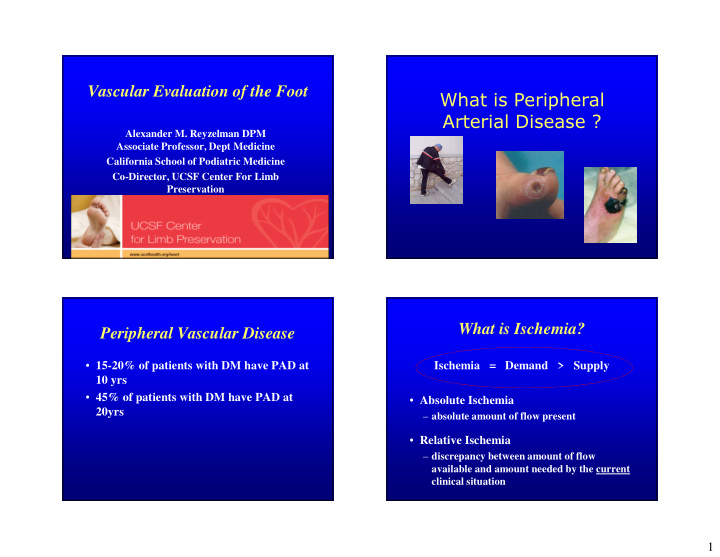



Vascular Evaluation of the Foot What is Peripheral Arterial Disease ? Alexander M. Reyzelman DPM Associate Professor, Dept Medicine California School of Podiatric Medicine Co-Director, UCSF Center For Limb Preservation What is Ischemia? Peripheral Vascular Disease • 15-20% of patients with DM have PAD at Ischemia = Demand > Supply 10 yrs • 45% of patients with DM have PAD at • Absolute Ischemia 20yrs – absolute amount of flow present • Relative Ischemia – discrepancy between amount of flow available and amount needed by the current clinical situation 1
History and Physical Exam • Presence of hair • Warm foot • Normal skin color • Palpation of pulses • Status of the nail plates History and Physical Exam • Significant vascular disease present in 20% of patients with normal clinical exam… • Ischemia more likely with: – location: toe or heel ulcer – etiology: unknown or pressure area – diminished pulses, shiny atrophic skin, infection – dependent rubor / elevation pallor 2
Noninvasive Modalities When to order NIV arterial testing? • Chronic non-healing ulcer/wound • Ankle Brachial Index • Pre-operatively to assess healing of • Toe Brachial Index proposed foot surgery • Toe Pressure • Ulcers of the digits, or boney • Segmental Pressures prominences • Doppler waveforms • Symptoms of claudication • Photoplethysmography • Pulse Volume Recordings ABI / TBI Medial Calcinosis • Ankle Brachial • Toe Brachial Index: • Tunica media Index: – ratio of hallux / arm • neuropathy – ratio of ankle / arm systolic pressure systolic blood • elevated pressures – > 0.6 low risk pressure – < 0.2 severe risk – normal 0.9 to 1.2 – digital vessels less – false elevation in DM affected by due to medial calcification in DM calcification – good screening test in • Goebel and Fuessel, Edmonds non-diabetic patients 3
Ankle and Toe Indices Doppler Waveforms • ABI Exam: • TBI Exam: • Interpretation – triphasic/biphasic/monophasic – normal flow appears as narrow peak, followed by one or two smaller peaks – faster flow --> higher audible pitch, waveform resembles teepee – slower flow--> lower pitch, igloo waveform – as flow deteriorates, waves flatten Doppler Waveform – Doppler Waveform - Monophasic Triphasic and Biphasic 4
Photoplethysmography PVR - Reflected Wave Absent • Transmission of IR light into tissue • Reflection varies with blood content of microcirculation • Transducer attached to digits for waveform Peripheral Arterial Disease: PVR - Blunted and Bowed PAD • Atherosclerosis • Atherosclerotic lesions cause arterial blockages (stenosis & occlusion) • Affects blood flow to critical arteries that supply brain, vital organs, and limbs • Frequently affects lower extremities • Associated with smoking, high blood pressure, diabetes, age, and hypercholesterolemia 5
Prevalence of PAD Increases With Age Prevalence of PAD Rotterdam Study (ABI <0.9) 1 San Diego Study (PAD by noninvasive tests) 2 Category Diagnosis Prevalence 60 Asymptomatic ABI < 0.9 >50% Patients With PAD (%) 50 4-6 million 40 30 Claudication Muscle pain, ache, 30%-35% cramps, fatigue 2-4 million 20 10 Critical Limb Pain at rest, <10% 0 55-59 60-64 65-69 70-74 75-79 80-84 85-89 Ischemia ulceration, 400,000-1 million Age (years) gangrene ABI=ankle-brachial index 1. Meijer WT, et al. Arterioscler Thromb Vasc Biol . 1998;18:185-192. 2. Criqui MH, et al. Circulation . 1985;71:510-515. Hiatt WR, NEJM 2001 Symptoms Where is the patient along the risk spectrum of vascular • Pain in buttocks, thigh, calf, arch disease? • Night ischemic pain A thorough assessment by history and exam should give you an idea 6
Peripheral Arterial Disease Peripheral Arterial Disease • Intermittent • Intermittent claudication claudication – “claudico” – to limp – “claudico” – to limp – Pain with walking – Pain with walking – Relieved by rest – Relieved by rest • Critical Limb • Critical Limb Ischemia Ischemia – Pain at rest, ulcers, or – Pain at rest, ulcers, or gangrene gangrene Intermittent Claudication Intermittent Claudication Measured in amount of blocks • Differential Diagnosis – Pseudoclaudication Reproducible – Degenerative Joint Disease Consistent – Diabetic Peripheral Neuropathy Not Limb Threatening 7
Diabetic vs. Nondiabetic Natural History of CLI Ischemic Patterns 1 Year Outcomes Critical Limb • Diabetic: • Nondiabetic: Ischemia 1%-2% – Distal: popliteal, – Proximal: aorta, ‘trifurcation,’ tibial, iliac, femoral pedal Alive with – Collateral Pathways: Amputation Dead – Axial Pathways: •Rest Pain both limbs 25% 25% internal iliac, aorta, iliac, 50% profunda femoral, •Ulceration superficial femoral tibial Weitz JI, Circulation 1996 – Usually noncalcified •Gangrene – Calcified vessel walls – Symmetrical – Symmetrical Timing of Vascular Assessment History and Physical Exam • Hx of CABG • Thigh, buttocks, calf • In the acute • In routine outpatient pain upon walking • Hx of CEA presentation: management: • Hx of previous • Hx of tobacco – priority is to address – initial evaluation ulcerations and how limb threatening • Hx of MI – non-healing wound long it took to heal infection – follow progression of • Hx of CVA – should not delay known disease • Hx of Angina necessary debridement – prompt bypass integral to limb salvage 8
History and Physical Exam Indications • Claudication – many classic symptoms • Rest pain masked or absent in DM • Slow healing/non-healing ulcer/wound • claudication, rest pain • coolness / pallor absent due • Gangrene to a/v shunting • brisk capillary refill time • Pre-operatively to assess healing potential false • pulses can mislead due to segmental nature of disease Sykes - Assessment 5 Minute Hyperemia Test • Differentiates between organic occlusive disease vs. vasospastic disease • Look for color return – Immeidate – 5-8 seconds – > 10 seconds 9
10
11
12
Recommend
More recommend